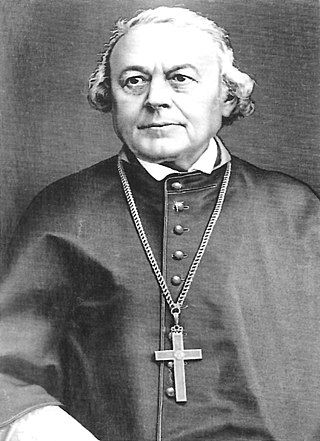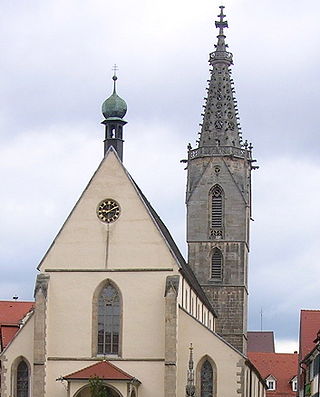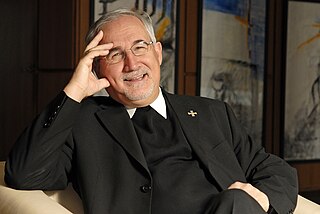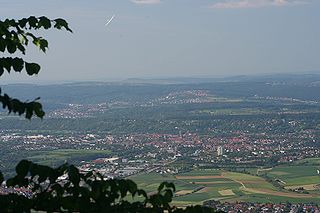
Cologne Cathedral is a cathedral in Cologne, North Rhine-Westphalia belonging to the Catholic Church. It is the seat of the Archbishop of Cologne and of the administration of the Archdiocese of Cologne. It is a renowned monument of German Catholicism and Gothic architecture and was declared a World Heritage Site in 1996. It is Germany's most visited landmark, attracting an average of 6 million people a year. At 157 m (515 ft), the cathedral is the tallest twin-spired church in the world, the second tallest church in Europe after Ulm Minster, and the third tallest church of any kind in the world.

The Neckar is a 362-kilometre-long (225 mi) river in Germany, mainly flowing through the southwestern state of Baden-Württemberg, with a short section through Hesse. The Neckar is a major right tributary of the Rhine. Rising in the Schwarzwald-Baar-Kreis near Schwenningen in the Schwenninger Moos conservation area at a height of 706 m (2,316 ft) above sea level, it passes through Rottweil, Rottenburg am Neckar, Kilchberg, Tübingen, Wernau, Nürtingen, Plochingen, Esslingen, Stuttgart, Ludwigsburg, Marbach, Heilbronn and Heidelberg, before discharging on average 145 m3/s (5,100 cu ft/s) of water into the Rhine at Mannheim, at 95 m (312 ft) above sea level, making the Neckar its 4th largest tributary, and the 10th largest river in Germany. Since 1968, the Neckar has been navigable for cargo ships via 27 locks for about 200 kilometres (120 mi) upstream from Mannheim to the river port of Plochingen, at the confluence with the Fils.

Karl Josef von Hefele was a Roman Catholic bishop and theologian of Germany.

Berlin Cathedral, also known as the Evangelical Supreme Parish and Collegiate Church, is a monumental German Protestant church and dynastic tomb on the Museum Island in central Berlin. Having its origins as a castle chapel for the Berlin Palace, several structures have served to house the church since the 15th century. The present collegiate church was built from 1894 to 1905 by order of Emperor William II according to plans by Julius Raschdorff in Renaissance and Baroque Revival styles. The listed building is the largest Protestant church in Germany and one of the most important dynastic tombs in Europe. In addition to church services, the cathedral is used for state ceremonies, concerts and other events.

Hildesheim Cathedral, officially the Cathedral of the Assumption of Mary or simply St. Mary's Cathedral, is a medieval Roman Catholic cathedral in the city centre of Hildesheim in Lower Saxony, Germany, that serves as the seat of the Diocese of Hildesheim. The cathedral has been on the UNESCO World Cultural Heritage list since 1985, together with the nearby St. Michael's Church because of its unique art and outstanding Romanesque architecture.

Rottenburg am Neckar is a medium-sized town in the administrative district (Landkreis) of Tübingen in Baden-Württemberg, Germany. It lies about 50 kilometres southwest of the provincial capital Stuttgart and about 12 km (7 mi) southwest of the district town Tübingen. Rottenburg is the second-largest town of the district after Tübingen and makes up a secondary centre for the surrounding community. Since 1 May 1972, Rottenburg am Neckar has been a district town. Rottenburg agreed to an administrative collective with the municipalities of Hirrlingen, Neustetten and Starzach.

The Diocese of Rottenburg-Stuttgart is a Latin Church ecclesiastical territory or diocese of the Catholic Church in Germany. It is a suffragan in the ecclesiastical province of the metropolitan Archdiocese of Freiburg in Baden-Württemberg, Bundesland. It covers the same territory of the former Kingdom of Wurttemberg.

Gebhard Fürst is a German prelate of the Catholic Church who was the Bishop of Rottenburg-Stuttgart from 2000 to 2023.

St Peter's Cathedral is a Roman Catholic church and former cathedral in Worms, southern Germany.

Kirchheim unter Teck is a town in Baden-Württemberg, Germany, in the district of Esslingen. It is located on the small river Lauter, a tributary of the Neckar. It is 10 km near the Teck castle, approximately 35 kilometres southeast of Stuttgart. It is the fourth city in the Esslingen district, forming a district centre for the surrounding communities.

Michael Sattler was a monk who left the Roman Catholic Church during the Protestant Reformation to become one of the early leaders of the Anabaptist movement. He was particularly influential for his role in developing the Schleitheim Confession. His leadership has been seen as stabilizing and giving direction to the early Anabaptist movement after the first leaders had been scattered or martyred.

Paderborn Cathedral is the cathedral of the Catholic Archdiocese of Paderborn. It is located in the city centre of Paderborn, North Rhine-Westphalia, Germany. The cathedral is dedicated to Saint Mary, Saint Kilian and Saint Liborius. The official German name is Hoher Dom Ss. Maria, Liborius und Kilian.

Frankfurt Cathedral, officially Imperial Dome of Saint Bartholomew, is a Roman Catholic Gothic church located in the heart of Frankfurt am Main, Germany. It is dedicated to Saint Bartholomew.

Hirrlingen is a municipality in the district of Tübingen in Baden-Württemberg in Germany. Hirrlingen is located about 15 kilometers southwest from Tübingen.
Wilhelm Reublin was a leading figure of the Swiss Brethren movement. Reublin was born in 1484 in Rottenburg am Neckar. In 1521, after having studied theology in Freiburg and Tübingen, Reublin became the pastor at St. Alban in Basel and began to advocate reform. St. Alban was soon the center of the evangelical movement in Basel. In the Fall of 1522 Reublin was expelled from the city for his Reformation sermons and moved to Witikon in 1524, where he became the local pastor and preached against infant baptism. Reublin was with Conrad Grebel and Felix Manz in Zürich in January 1525 at the birth of the Anabaptist movement. Reublin took part in a disputation on 17 January 1525 after which Grebel, Manz and Reublin were given eight days to leave the canton.

Saint Mary's Cathedral in Hamburg was the cathedral of the ancient Roman Catholic Archdiocese of Hamburg, which was merged in personal union with the Diocese of Bremen in 847, and later in real union to form the Archdiocese of Hamburg-Bremen, as of 1027.

The Bernward Doors are the two leaves of a pair of Ottonian or Romanesque bronze doors, made c. 1015 for Hildesheim Cathedral in Germany. They were commissioned by Bishop Bernward of Hildesheim (938–1022). The doors show relief images from the Bible, scenes from the Book of Genesis on the left door and from the life of Jesus on the right door. They are considered a masterpiece of Ottonian art, and feature the oldest known monumental image cycle in German sculpture, and also the oldest cycle of images cast in metal in Germany.

The Neckar-Odenwald Limes is a collective term for two, very different early sections of the Upper Germanic-Rhaetian Limes, a Roman defensive frontier line that may have been utilised during slightly different periods in history. The Neckar-Odenwald Limes consists of the northern Odenwald Limes (Odenwaldlimes), a cross-country limes with camps, watchtowers and palisades, which linked the River Main with the Neckar, and the adjoining southern Neckar Limes (Neckarlimes), which in earlier research was seen as a typical 'riverine limes', whereby the river replaced the function of the palisade as an approach obstacle. More recent research has thrown a different light on this way of viewing things that means may have to be relativized in future. The resulting research is ongoing.

Halle Cathedral is an Evangelical Reformed Church, and is the oldest surviving church in the old part of the city Halle, Saale. Beside it resided the Archbishop of Magdeburg, who ruled the city for a long period. Albert of Brandenburg remodelled the church's exterior from 1520 onwards and built the neighbouring Neue Residenz, aiming to make the church one of the most influential and powerful monasteries north of the Alps.
Willy Weyres was a German architect and academic teacher. He was Kölner Dombaumeister from 1944 to 1972, diocesan master builder for the Archdiocese of Cologne for more than ten years, and full professor of architectural history and monument preservation at the RWTH Aachen from 1955 until his retirement in 1972. Under his leadership, the Cologne Cathedral was restored and further developed after the Second World War.



















